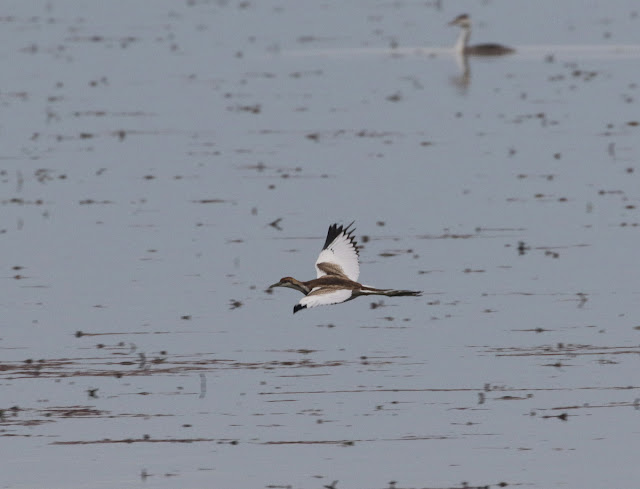This a year a bird chose Oizumi Ryokuchi (the same park as the Grey-backed Thrush last winter), there was simply no way I was going to trek into the southern reaches of Osaka for yet another Red-breasted Fly! When it transformed into a Taiga however, that was a different matter. Both species are scarce autumn migrants in Japan, mainly restricted to the Japan Sea islands; my feeling is that Taiga is the commoner of the two at that time. Both also overwinter in Japan but Red-breasted is definitely more numerous, this Taiga is the first wintering bird I've seen.
Separation of these two scarce flycatchers can be tricky, more so on the islands where observers are less likely to hang around too long waiting for a secretive flycatcher to reappear when there many be many other interesting birds vying for attention. A bird in an Osaka park in winter, on the other hand, doesn't have much competition and good views are guaranteed with a little patience... and photographers' mealworms.
To my eyes most plumage features are open to interpretation, even the diagnostic blacker-than-black uppertail coverts of Taiga. If I see black uppertail coverts which are clearly darker than the tail then all well and good, however, if I don't see blacker coverts can I be sure they are a lighter shade than the tail or is it that I haven't yet seen them well enough, that the angle hasn't been quite right, or that the light is too bright/dim to detect a difference.
Similarly, if the supercilium is obviously brown it must be a Red-breasted, right? I suppose so, and some RBFs do have very warm brown supercilia, others throw in at least a bit of grey and some irds do give a brown-capped impression at times. Is Taiga's supercilium always pure grey throughout? It certainly tends to be that way but I wouldn't stake an ID on head pattern.
The tertial pattern isn't supposed to be diagnostic but I wonder if this might be a one way feature. I've yet to see a Red-breasted with a white edge and terminal spot, 'thorn', on the outer web, they always (the birds I've seen) have a warmer, buffy-brown colouration. Do Taiga sometimes lack a white edge? I don't know, I haven't seen one that lacks this feature but that doesn't mean much considering how few I've seen. Until I learn otherwise this white outer edge and thorn seem a strong indicator to me, and far more easily seen than the uppertail coverts.
So much for plumage.
The bill strikes me as the at-a-glance indicator to species for two reasons. RBF frequently has a paler base to the lower mandible, this is often diffusely very extensive when seen from below. Taiga normally appears completely dark and any pale area there might be will be restricted to a very limited area at the base. The shape of the bill is even more eye-catching. RBF has a comparatively delicate bill in proportion to the head, less deep at the base and with a straighter keel. Thus the curve towards the tip is more prominent on the upper mandible. Taiga has a much deeper-based bill, which isn't in the least delicate, with both mandibles curving towards the tip. It looks more like a bullet stuck on the front of the head.
 |
| The same individual showing the finer bill. |
 |
| Another RBF (Jan 2007) with warmer underparts, not all look as obvious as this one. Again, crown to eyeline is uniformly brown and the fine bill is a giveaway. |
 |
| The same bird as above. The capped effect produced by the contrast between supercilium and crown is more easily seen here. The white edged tertials are outstanding and the bill enormous. |
 |
| As above. The bill is far heavier in proportion to the head compared to RBF and those uppertail coverts really are black. |
The holy grail of local photographers is an adult male Red-breasted. It isn't really relevant here as it isn't difficult to identify but it's worth adding a couple of shots because these particular images show to better advantage the difference between uppertail coverts and tail as well as how extensively pale the lower mandible can be.
 |
| Adult male RBF (Jan 2016). Setting aside the paler fringes, even the bases of the uppertail coverts are less black than the tail. |
Fortunately there's always the call to put an end to any arguments and all these wintering birds have been quite vocal.












































